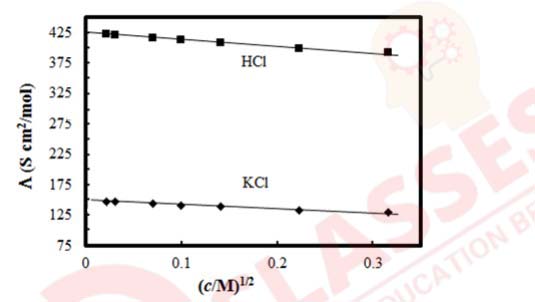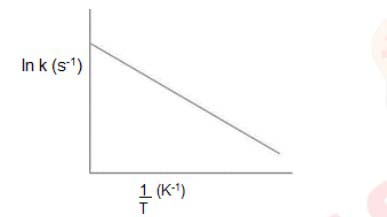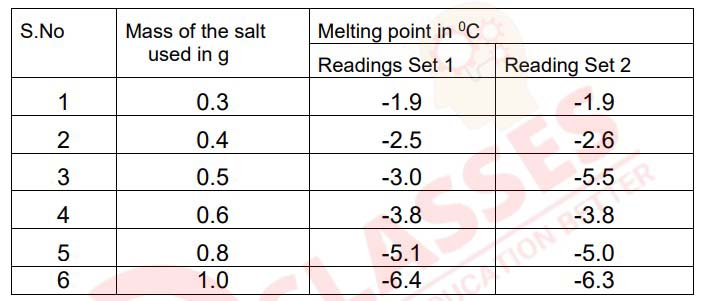Class 12 CBSE Chemistry Specimen 2023
Maximum Marks: 70
Time Allowed: Three hours
There are 35 questions in this question paper with internal choice.
SECTION A consists of 18 multiple-choice questions carrying 1 mark each.
SECTION B consists of 7 very short answer questions carrying 2 marks each.
SECTION C consists of 5 short answer questions carrying 3 marks each.
SECTION D consists of 2 case- based questions carrying 4 marks each.
SECTION E consists of 3 long answer questions carrying 5 marks each.
All questions are compulsory.
Use of log tables and calculators is not allowed
Section-A
Question 1
The major product of acid catalysed dehydration of 1-methylcyclohexanol is:
a. 1-methylcyclohexane
b. 1-methylcyclohexene
c. 1-cyclohexylmethanol
d. 1-methylenecyclohexane
Solution

Question 2
Which one of the following compounds is more reactive towards SN1 reaction?
a. CH2=CHCH2Br
b. C6H5CH2Br
c. C6H5CH (C6H5)Br
d. C6H5CH(CH3) Br
Solution

Question 3
KMnO4 is coloured due to:
a. d-d transitions
b. charge transfer from ligand to metal
c. unpaired electrons in d orbital of Mn
d. charge transfer from metal to ligand
Solution

Question 4
Which radioactive isotope would have the longer half- life 15O or
19O? (Given rate
constants for 15O and 19O are 5.63x 10-3 s-1 and k = 2.38 x
10-2s-1
respectively.)
a. 15O
b. 19O
c. Both will have the same half-life
d. None of the above, information given is insufficient
Solution

Question 5
The molar conductivity of CH3COOH at infinite dilution is 390
Scm2
/mol. Using the
graph and given information, the molar conductivity of CH3COOK will be:

a. 100 Scm2
/mol
b. 115 Scm2
/mol
c. 150 Scm2
/mol
d. 125 Scm2
/mol
Solution

Question 5 (For Visually Challenged Learners)
What is the molar conductance at infinite dilution for sodium chloride if the molar
conductance at infinite dilution of Na+ and Cl- ions are 51.12 × 10-4
Scm2
/mol and
73.54× 10-4 Scm2
/mol respectively?
a. 124.66 Scm2
/mol
b. 22.42 Scm2
/mol
c. 198.20 Scm2
/mol
d. 175.78 Scm2
/mol
Solution

Question 6
For the reaction, A +2B → AB2, the order w.r.t. reactant A is 2 and
w.r.t. reactant B.
What will be change in rate of reaction if the concentration of A is doubled and B is
halved?
a. increases four times
b. decreases four times
c. increases two times
d. no change
Solution

Question 7
Arrange the following in the increasing order of their boiling points:
A : Butanamine, B: N,N-Dimethylethanamine, C: N- Etthylethanaminamine
a. C < B < A
b. A < B < C
c. A < C < B
d. B < C < A
Solution

Question 8
The CFSE of [CoCl6]
3-
is 18000 cm-1
the CFSE for [CoCl4]
- will be:
a. 18000 cm-1
b. 8000 cm-1
c. 2000 cm-1
d. 16000 cm-1
Solution

Question 9
What would be the major product of the following reaction?
C6H5-CH2-OC6H5 + HBr → A + B
a. A= C6H5CH2OH , B= C6H6
b. A=C6H5CH2OH ,B= C6H5Br
c. A=C6H5CH3 ,B= C6H5Br
d. A=C6H5CH2Br , B= C6H5OH
Solution

Question 10
Which of the following statements is not correct for amines?
a. Most alkyl amines are more basic than ammonia solution.
b. pKb value of ethylamine is lower than benzylamine.
c. CH3NH2 on reaction with nitrous acid releases NO2 gas.
d. Hinsberg’s reagent reacts with secondary amines to form sulphonamides.
Solution

Question 11
Which of the following tests/ reactions is given by aldehydes as well as
ketones?
a. Fehling’s test
b. Tollen’s test
c. 2,4 DNP test
d. Cannizzaro reaction
Solution

Question 12
Arrhenius equation can be represented graphically as follows:

The (i) intercept and (ii) slope of the graph are:
a. (i) ln A (ii) Ea/R
b. (i) A (ii) Ea
c. (i)ln A (ii) - Ea/R
d. (i) A (ii) -Ea
Solution

Question 12 (FOR VISUALLY CHALLENGED LEARNERS)
The unit of rate constant for the reaction
2A + 2B → A2B2
which has rate = k [A]2
[B] is:
a. mol L-1s-1
b. s-1
c. mol L-1
d. mol-2 L2s-1
Solution

Question 13
The number of ions formed on dissolving one molecule of
FeSO4.(NH4)2SO4.6H2O
in water is:
a. 3
b. 4
c. 5
d. 6
Solution

Question 14
The oxidation of toluene to benzaldehyde by chromyl chloride is called
a. Etard reaction
b. Riemer-Tiemann reaction
c. Stephen’s reaction
d. Cannizzaro’s reaction
Solution

Question 15
Given below are two statements labelled as Assertion (A) and Reason (R)
Assertion (A): An ether is more volatile than an alcohol of comparable molecular
mass.
Reason (R): Ethers are polar in nature.
Select the most appropriate answer from the options given below:
a. Both A and R are true and R is the correct explanation of A
b. Both A and R are true but R is not the correct explanation of A.
c. A is true but R is false.
d. A is false but R is true.
Solution

Question 16
Given below are two statements labelled as Assertion (A) and Reason (R)
Assertion (A): Proteins are found to have two different types of secondary
structures viz alpha-helix and beta-pleated sheet structure.
Reason (R): The secondary structure of proteins is stabilized by hydrogen
bonding.
Select the most appropriate answer from the options given below:
a. Both A and R are true and R is the correct explanation of A
b. Both A and R are true but R is not the correct explanation of A.
c. A is true but R is false.
d. A is false but R is true.
Solution

Question 17
Given below are two statements labelled as Assertion (A) and Reason (R)
Assertion (A) : Magnetic moment values of actinides are lesser than the
theoretically predicted values.
Reason (R) : Actinide elements are strongly paramagnetic.
Select the most appropriate answer from the options given below:
a. Both A and R are true and R is the correct explanation of A
b. Both A and R are true but R is not the correct explanation of A.
c. A is true but R is false.
d. A is false but R is true.
Solution

Question 18
Given below are two statements labelled as Assertion (A) and Reason (R)
Assertion (A): Tertiary amines are more basic than corresponding secondary
and primary amines in gaseous state.
Reason (R): Tertiary amines have three alkyl groups which cause +I effect.
Select the most appropriate answer from the options given below:
a. Both A and R are true and R is the correct explanation of A
b. Both A and R are true but R is not the correct explanation of A.
c. A is true but R is false.
d. A is false but R is true.
Solution

SECTION-B
Question 19
A first-order reaction takes 69.3 min for 50% completion. What is the time needed
for
80% of the reaction to get completed?
(Given: log 5 =0.6990, log 8 = 0.9030, log 2 = 0.3010)
Solution

Question 20
Account for the following:
a. There are 5 OH groups in glucose
b. Glucose is a reducing sugar
Solution


OR
What happens when D – glucose is treated with the following reagents
a. Bromine water
b. HNO3
Solution

Question 21
Give reason for the following:
a. During the electrophilic substitution reaction of haloarenes, para
substituted derivative is the major product.
b. The product formed during SN1
reaction is a racemic mixture.
Solution

OR
a. Name the suitable alcohol and reagent, from which 2-Chloro-2-methyl
propane can be prepared.
b. Out of the Chloromethane and Fluoromethane , which one is has higher
dipole moment and why?
Solution

Question 22
.The formula Co(NH3)5CO3Cl could represent a carbonate or a
chloride. Write the
structures and names of possible isomers.
Solution

Question 23
Corrosion is an electrochemical phenomenon. The oxygen in moist air reacts as
follows:
O2(g) + 2H2O(l) + 4e- → 4OH-
(aq).
Write down the possible reactions for corrosion of zinc occurring at anode, cathode, and
overall reaction to form a white layer of zinc hydroxide.
Solution

Question 24
Explain how and why will the rate of reaction for a given reaction be affected
when
a. a catalyst is added
b. the temperature at which the reaction was taking place is decreased
Solution

SECTION-C
Question 25
Write the reaction and IUPAC name of the product formed when 2-Methylpropanal (isobutyraldehyde) is treated with ethyl magnesium bromide followed by hydrolysis.
Solution

Question 26
Write the equations for the following reaction:
a. Salicylic acid is treated with acetic anhydride in the presence of conc.
H2SO4
b. Tert butyl chloride is treated with sodium ethoxide.
c. Phenol is treated with chloroform in the presence of NaOH
Solution

Question 27
Using Valence bond theory, explain the following in relation to the paramagnetic
complex [Mn(CN)6]
3-
a. type of hybridization
b. magnetic moment value
c. type of complex – inner, outer orbital complex
Solution

Question 28
Answer the following questions:
a. State Henry’s law
b. Assume that argon exerts a partial pressure of 6 bar. Calculate the
solubility of argon gas in water. (Given Henry’s law constant for argon
dissolved in water, KH = 40kbar)
Solution

Question 29
Give reasons for any 3 of the following observations:
a. Aniline is acetylated before nitration reaction.
b. pKb of aniline is lower than the m-nitroaniline.
c. Primary amine on treatment with benzenesulphonyl chloride forms a
product which is soluble in NaOH however secondary amine gives product
which is insoluble in NaOH.
d. Aniline does not react with methyl chloride in the presence of anhydrous
AlCl3 catalyst.
Solution

Question 30
a. Identify the major product formed when 2-cyclohexylchloroethane
undergoes a dehydrohalogenation reaction. Name the reagent which is
used to carry out the reaction.
b. Why are haloalkanes more reactive towards nucleophilic substitution
reactions than haloarenes and vinylic halides?
Solution

OR
a. Name the possible alkenes which will yield 1-chloro-1-methylcyclohexane
on their reaction with HCl. Write the reactions involved.
b. Allyl chloride is hydrolysed more readily than n-propyl chloride. Why?
Solution

SECTION-D
Question 31
Strengthening the Foundation: Chargaff Formulates His "Rules"
Many people believe that James Watson and Francis Crick discovered DNA in the
1950s. In reality, this is not the case. Rather, DNA was first identified in the late
1860s by Swiss chemist Friedrich Miescher. Then, in the decades following
Miescher's discovery, other scientists--notably, Phoebus Levene and Erwin
Chargaff--carried out a series of research efforts that revealed additional details
about the DNA molecule, including its primary chemical components and the ways
in which they joined with one another. Without the scientific foundation provided
by these pioneers, Watson and Crick may never have reached their
groundbreaking conclusion of 1953: that the DNA molecule exists in the form of a
three-dimensional double helix.
Chargaff, an Austrian biochemist, as his first step in this DNA research, set out to
see whether there were any differences in DNA among different species. After
developing a new paper chromatography method for separating and identifying
small amounts of organic material, Chargaff reached two major conclusions:
(i) the nucleotide composition of DNA varies among species.
(ii) Almost all DNA, no matter what organism or tissue type it comes from maintains
certain properties, even as its composition varies. In particular, the amount of
adenine (A) is similar to the amount of thymine (T), and the amount of guanine (G)
approximates the amount of cytosine (C). In other words, the total amount of
purines (A + G) and the total amount of pyrimidines (C + T) are usually nearly
equal. This conclusion is now known as "Chargaff's rule."
Chargaff’s rule is not obeyed in some viruses. These either have single- stranded
DNA or RNA as their genetic material.
Answer the following questions:
a. A segment of DNA has 100 adenine and 150 cytosine bases. What is the
total number of nucleotides present in this segment of DNA?
b. A sample of hair and blood was found at two sites. Scientists claim that the
samples belong to same species. How did the scientists arrive at this
conclusion?
(a) DNA- double helix
(b) DNA-single helix
(c) RNA? What do
you infer from this data?
OR
How can Chargaff’s rule be used to infer that the genetic material of an
organism is double- helix or single- helix?
Solution

Question 32
Henna is investigating the melting point of different salt solutions.
She makes a salt solution using 10 mL of water with a known mass of NaCl salt.
She puts the salt solution into a freezer and leaves it to freeze.
She takes the frozen salt solution out of the freezer and measures the
temperature when the frozen salt solution melts.
She repeats each experiment.

Assuming the melting point of pure water as 0 oC, answer the following
questions:
a. One temperature in the second set of results does not fit the pattern.
Which temperature is that? Justify your answer.
b. Why did Henna col border border-1lect two sets of results?
c. In place of NaCl, if Henna had used glucose, what would have been the
melting point of the solution with 0.6 g glucose in it?
OR
What is the predicted melting point if 1.2 g of salt is added to 10 mL of
water? Justify your answer
Solution


SECTION-E
Question 33
a. Why does the cell voltage of a mercury cell remain constant during its
10
lifetime?
b. Write the reaction occurring at anode and cathode and the products of
electrolysis of aq KCl.
c. What is the pH of HCl solution when the hydrogen gas electrode shows
a potential of -0.59 V at standard temperature and pressure?
OR
a. Molar conductivity of substance “A” is 5.9×103 S/m and “B” is 1 x 10-16
S/m. Which of the two is most likely to be copper metal and why?
b. What is the quantity of electricity in Coulombs required to produce 4.8 g of
Mg from molten MgCl2? How much Ca will be produced if the same
amount of electricity was passed through molten CaCl2? (Atomic mass of
Mg = 24 u, atomic mass of Ca = 40 u).
c. What is the standard free energy change for the following reaction at room
temperature? Is the reaction spontaneous?
Sn(s) + 2Cu2+ (aq) Sn2+ (aq) + 2Cu+(s)
b. What is the quantity of electricity in Coulombs required to produce 4.8 g of Mg from molten MgCl2? How much Ca will be produced if the same amount of electricity was passed through molten CaCl2? (Atomic mass of Mg = 24 u, atomic mass of Ca = 40 u).
c. What is the standard free energy change for the following reaction at room temperature? Is the reaction spontaneous?
Sn(s) + 2Cu2+ (aq) Sn2+ (aq) + 2Cu+(s)
Solution





Question 34
A hydrocarbon (A) with molecular formula C5H10 on ozonolysis gives two products
(B) and ( C). Both (B) and (C) give a yellow precipitate when heated with iodine in
presence of NaOH while only (B) give a silver mirror on reaction with Tollen’s
reagent.
a. Identify (A), (B) and (C).
b. Write the reaction of B with Tollen’s reagent
c. Write the equation for iodoform test for C
d. Write down the equation for aldol condensation reaction of B and C
OR
An organic compound (A) with molecular formula C2Cl3O2H is obtained
when (B)
reacts with Red P and Cl2. The organic compound (B) can be obtained on the
reaction of methyl magnesium chloride with dry ice followed by acid hydrolysis.
a. Identify A and B
b. Write down the reaction for the formation of A from B. What is this reaction
called?
c. Give any one method by which organic compound B can be prepared from
its corresponding acid chloride.
d. Which will be the more acidic compound (A) or (B)? Why?
e. Write down the reaction to prepare methane from the compound (B).
a. Identify A and B
b. Write down the reaction for the formation of A from B. What is this reaction called?
c. Give any one method by which organic compound B can be prepared from its corresponding acid chloride.
d. Which will be the more acidic compound (A) or (B)? Why?
e. Write down the reaction to prepare methane from the compound (B).
Solution


Question 35
Answer the following:
a. Why are all copper halides known except that copper iodide?
b. Why is the Eo (V3+/V2+)
value for vanadium comparatively low?
c. Why HCl should not be used for potassium permanganate titrations?
d. Explain the observation, at the end of each period, there is a slight
increase in the atomic radius of d block elements.
e. What is the effect of pH on dichromate ion solution?
Solution


Add a comment